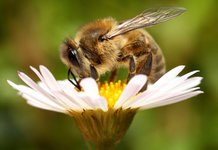
A lot of books have been written about bee diseases. Some diseases are treatable, others are incurable. However, beekeepers in practice, in reality, may encounter only some of them.
I will divide them into two main groups, as well as I will describe the symptomsso that the beginner does not miss the moment and begins timely treatment of insects. About what to do, I wrote earlier.
Infectious diseases
Many of them occur in the summer, since pathogens need high temperatures for development.

American foulbrood. This is a serious disease that is difficult to treat. The causative agent of the disease is the bacterium Bacillus larvae. It affects open brood in the pre-pupal stage.
The source of infection is bee bread, honey and the bees themselves.
The disease manifests itself only in the summer. Symptoms the following, the presence of putrefactive mass in the cells, and if you try to stretch this mass with a match, then it will stretch with a thin thread. There is also a pungent smell of wood glue.

European foulbrood. Such a disease is also susceptible to open brood. The causative agent is streptococcus pluton. The development of the disease occurs in the summer. Symptoms rotting larvae are in cells incorrectly, are located in a different form, emit an unpleasant smell of rotting meat.
Bagged brood. This disease affects open brood. Pathogen RNA-containing virus.Symptoms in this case, an unpleasant odor is absent, and at the last stage of infection, the larva somewhat resembles a bag with a rotting mass inside, which is easily removed from the cell.
As in the case with the rot, the disease requires a temperature above 30-35 degrees, so infection is only possible in the summer.
Ascospherosis. The causative agent is the mushroom ascosphere apis. Infection is susceptible to open brood, mainly turut. For reproduction, the mushroom requires wet and not hot weather. Therefore, the disease most often manifests itself in the spring. Symptoms in the final stage of the disease, the larva hardens and takes on the color of the chalk.
Viral paralysis. The disease can occur both in spring and summer. The causative agents are about 20 pathogens. Symptoms: in this case, the bees are affected by the nervous system. They come into an agitated state, inadequate behavior, falling of the hairline and darkening of the abdomen are observed. If measures are not taken in time, the family will die.
Invasive Bee Disease
Nosematosis. This disease is caused by the Nozema parasite, which develops in the intestines of the bee. Most often, the disease occurs in late winter and early spring.
Symptoms in this case, the bee is not able to hold the fecal load, which leads to the bearing of the front wall of the hive, as well as the frames.

Varroatosis Is the most common bee disease.
The causative agent is the tick Varroa Jacobsoni. Affected adult bees, drones, as well as brood.
The danger of a tick lies in the fact that it is a carrier of other dangerous diseases.The disease is quarantined and requires preventive treatments throughout the season.
The exception is, only the period of honey collection.
Toxicosis is another group
There is a third group of diseases caused by malnutrition of bees. These are various toxicoses: nectar, mortar, pollen. But because of their infectiousness, and also most often self-healing, I don’t see any reason to describe them.
Summarize:
Do not forget that bee diseases, at least most of them, exist for a very long time. They fulfill an important function of selection - natural selection, as a result of which the weak die and the strong survive.
It is for this reason that experienced beekeepers worldwide breeders never use medicine in their practice. Affected families are simply destroyed.
Material for future breeding work is taken only from healthy and genetically resistant to various diseases of families.


























